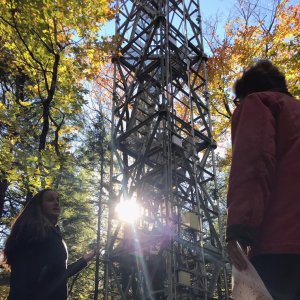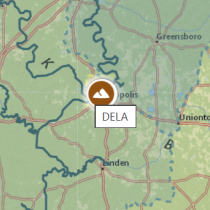New Hampshire Senator Shaheen Learns About the Value of NSF’s NEON
October 24, 2018
October is peak foliage season in the Bartlett Experimental Forest, an actively managed forest located in New Hampshire’s White Mountain National Forest. On October 19, U.S. Senator Jeanne Shaheen (NH-D), Ranking Member of the Senator Appropriations Commerce, Science, and Justice Subcommittee, visited NEON’s Bartlett Experimental Forest (BART) field site to learn firsthand about the NSF-funded, long-term, open access data collection program that will enable the scientific community to better assess how ecosystems change across the country. Shaheen was particularly interested in how the types of data, including mosquitoes and ticks, collected across NEON field sites will enable ecological forecasting models and allow scientists to study movement patterns of vectors of infectious disease.
Why Build a NEON Site at the Bartlett Experimental Forest?
BART serves as NEON’s northernmost site on the East Coast of the United States and is representative of a transitional eastern deciduous-to-boreal forest. The field site sits on 3,870 acres within the Bartlett Experimental Forest, which is managed by the U.S. Forest Service. The area is primarily filled with beech and hemlocks in the lower deciduous elevations, and stands of spruce and fir in the higher boreal elevations of the forest.
The U.S. Forest Service has been conducting research in the Bartlett since 1935 to study questions about ecological structure, function, and process in New England’s northern hardwood forests and to provide guidelines for managing timber and wildlife habitat. In recent decades, the Forest Service has studied relationships between vegetation management and the needs of wildlife throughout their life cycles, and has tested remote sensing technologies to estimate forest composition, structure and growth, and ecosystem processes such as nutrient cycling and carbon storage. Much of this research depends on long-term data collection to identify trends and create predictive models.
A NEON field site at the Bartlett was a natural fit. Battelle puts infrastructure into place at each field site that enables scientists to continuously monitor and assess the health of that ecosystem. Adding a NEON site to the Bartlett would exponentially increase the understanding of how the forest responds to land management practices, changing climates, and natural disturbances such as hurricanes, fires and beech scale-Nectria complex (beech bark disease).
NEON Data Collection at Bartlett
Battelle uses three collection systems at each NEON field site to collect data. Collection methods are standardized across field sites allowing for data comparisons between the BART data and the 80 other field sites in the NEON network. To collect meteorological data, a 116’ micrometeorological tower was installed at the Bartlett site. The sensors on the tower collect weather and climate data, including fluxes of carbon, water, and energy between terrestrial ecosystems and the atmosphere. In the tower’s airshed, an array of soil sensors collect soil health data. Throughout the 3,870 acre sampling area, field scientists establish hundreds of sampling plots to collect a variety of observations of plants, animals, soils and soil microbes. The scientists also collect samples that are processed, archived and made available for research studies. At peak vegetation greenness, NEON flies a light aircraft over the Bartlett to collect airborne remote sensing data of the forest.
Funding long-term environmental monitoring programs like NEON, that collect consistent, well-documented and high-quality data, results in a vast amount of data to study critical ecological questions at the local, regional, and continental scale. The data being collected at the Bartlett will allow us to better monitor the changing health of that forest, extend the research already taking place in the White Mountains, and allow scientists to better understand and predict how all our nation’s ecosystems will change over time.
NEON has been collecting data at the Bartlett since 2013 and currently has 78 data products available on the NEON data portal. These data are open access and freely available. Archival samples are also available upon request.

